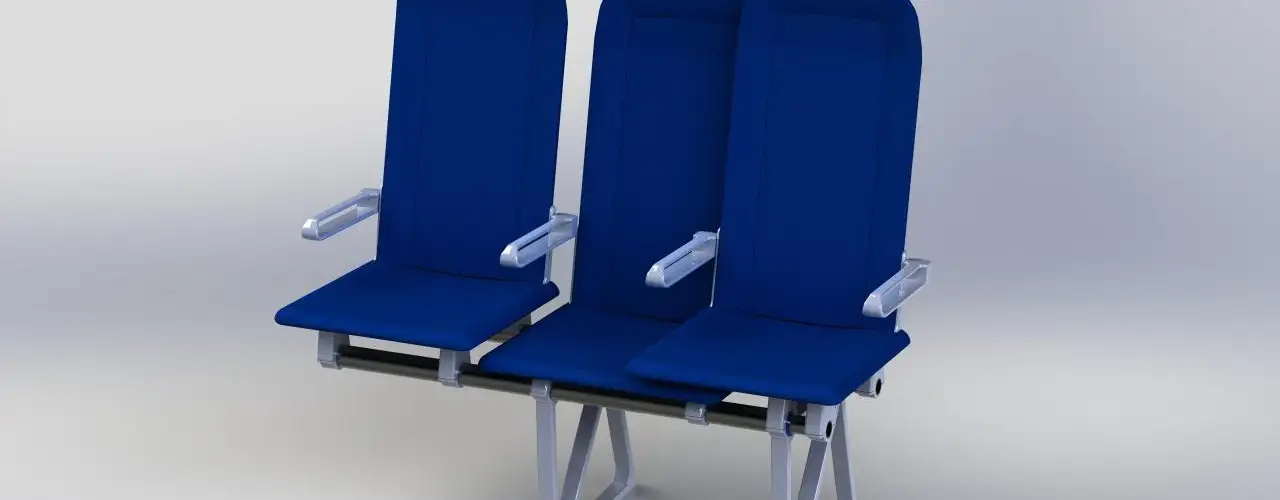
“Speed up the boarding process by installing seats in which the aisle seats slide over the middle seats to widen the aisle from a typical 19 inches to 43 inches.” That’s the pitch Molon Labe Designs is making to airlines for its new Slider Seat.
The idea makes sense: Boarding a flight can take up a lot of time, and Molon Labe Designs claims its innovative seat can cut that time in half. And shorter boarding times mean quicker turn-arounds at airports, so an airplane equipped with Slider Seats can fly an additional two hours each day.
The aisle seat slides a full foot over the middle seat, which is staggered below and behind the aisle and window seats. With sliding seats on both sides of the plane, the airline gains 24 inches of extra aisle space during the boarding process. Once everyone is onboard, the seat slides back out to the standard width.
Will it work? The obvious question is: What happens when the middle seat occupant shows up and can’t take his or her seat until the plane is full? Furthermore, will wider aisles ease the problem of inadequate overhead-bin capacity? After all, bin overcrowding typically adds a lot of time to the boarding process.
Molon Labe claims that its design permits the seat bottom of the lowered and staggered middle seat to be some three inches wider than the current standard. But the designer doesn’t say much about shoulder-level room—and shoulder room, not seat bottom, is the critical measure of seat width.
The initial drawing shows bare-bones economy seats with minimum padding and no recline, suitable only for high densities in short-haul flights. But the designer claims that airlines can get as much padding as they want.
I have no way of knowing how any individual airline might react to the Slider Seat. Other seat designers have proposed different approaches to staggered seats. So far, no airlines have adopted such a design, but this is the first approach that combines staggered seats with increased aisle room.
Whatever happens to Slider Seat, you can expect to see more such proposals. Airlines are under tremendous pressure to cut costs wherever they can, and seat- and cabin-interior designers are trying to devise products that will save time, increase the number of seats in cabins, and lower airplane weight. This one would cut boarding time and, from the looks of the drawing, could be installed with decreased legroom, meaning more seats per plane. Plus, it looks lightweight.
We’ve seen even more Spartan proposals in the past, such as standing room or leaning seats, floated by designers and manufacturers. So far, no takers. But don’t bet against any of these ideas.
Many big airlines—especially the legacy carriers—have clearly indicated that, for their rear cabins, low cost trumps comfort by a wide margin. So you have to take proposals like this seriously. Airlines can still turn out a really good product if you’re willing to pay a really high price. But if you aren’t, you can look forward to more and more squeezing. Regardless of what happens to Slider Seat, if you shop for the lowest fares, you can expect steady downgrading of comfort standards as far ahead as anyone can see.
Do you think planes should install Slider Seats?
You Might Also Like:
- Airlines Collected Billions in Bag Fees This Year
- Booking Holiday Airfare
- Why Are Rental Cars So Expensive in Some Destinations?
(Photo: Molon Labe Designs)
We hand-pick everything we recommend and select items through testing and reviews. Some products are sent to us free of charge with no incentive to offer a favorable review. We offer our unbiased opinions and do not accept compensation to review products. All items are in stock and prices are accurate at the time of publication. If you buy something through our links, we may earn a commission.
Related
Top Fares From
Today's Top Travel Deals
Brought to you by ShermansTravel
France: 8-Night Paris, Avignon & Nice...
Infinity Worldwide Vacations
 vacation
$2880+
vacation
$2880+
Poconos: 3 Nts in Garden of...
ResortsAndLodges.com
 hotel
$305+
hotel
$305+
7-Nt Canada & New England Cruise,...
Princess Cruises
 cruise
$839+
cruise
$839+



